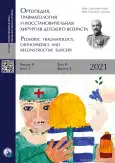Recurrent posterior elbow dislocation caused by congenital abnormalities in a 7-year-old child
- 作者: Proshchenko Y.N.1, Sigareva Y.A.1
-
隶属关系:
- H. Turner National Medical Research Center for Children’s Orthopedics and Trauma Surgery
- 期: 卷 9, 编号 2 (2021)
- 页面: 211-219
- 栏目: Clinical cases
- ##submission.dateSubmitted##: 13.11.2020
- ##submission.dateAccepted##: 12.04.2021
- ##submission.datePublished##: 09.07.2021
- URL: https://journals.eco-vector.com/turner/article/view/50129
- DOI: https://doi.org/10.17816/PTORS50129
- ID: 50129
如何引用文章
详细
BACKGROUND: Congenital posterior elbow dislocation in children is a rare and scarcely reported condition. Owing to the difficulties of an early primary diagnosis and the lack of a standardized management, we present a clinical case of an analysis of surgical treatment according to literature and based on our experience.
CLINICAL CASE: We present a case of congenital posterior elbow dislocation in a 7-year-old child. In the absence of a universal algorithm for surgical treatment, we performed an arthrotomy for visual assessment of articular surfaces, intervention on the capsule and tendons of m. brachialis, m. biceps brachii, m. brachioradialis, and modeling of the proximal epiphysis of the right radius.
DISCUSSION: We analyzed surgical treatment options and made an overview of the main stabilizers of the elbow joint that prevent elbow dislocations. There are few publications on this condition; to our knowledge, over the past 10 years, only two clinical cases of a similar pathology in children had been published. Not a single case of congenital elbow dislocation in the neonatal period has been described. We analyzed early clinical manifestations and possible causes of delayed primary diagnosis.
CONCLUSIONS: Recurrent posterior elbow dislocation of the congenital origin is associated with a functional deficiency of elbow joint stabilizers. In the neonatal period, these abnormalities are usually not detected. The first episode of dislocation may be triggered by a minor trauma without damaging the bone structures. Delayed primary diagnosis may be associated with the paucity of clinical symptoms and compensatory functionality in children. The decision on surgical correction should be based on the analysis of structural anatomical changes in the assessment, of which magnetic resonance imaging plays an important role.
全文:
作者简介
Yaroslav Proshchenko
H. Turner National Medical Research Center for Children’s Orthopedics and Trauma Surgery
Email: yar2011@list.ru
ORCID iD: 0000-0002-3328-2070
SPIN 代码: 6953-3210
MD, PhD
俄罗斯联邦, Saint PetersburgYulia Sigareva
H. Turner National Medical Research Center for Children’s Orthopedics and Trauma Surgery
编辑信件的主要联系方式.
Email: julsigareva@gmail.com
ORCID iD: 0000-0003-3842-2113
SPIN 代码: 3911-4108
MD, clinical resident
俄罗斯联邦, Saint Petersburg参考
- Milch H. Bilateral recurrent dislocation of the ulna at the elbow. J Bone Joint Surg. 1936;18:777.
- Farr S, Rois J, Ganger R, Girsch W. Reconstruction for elbow instability caused by congenital aplasia of the ulnar coronoid process — a case report. Acta Orthop. 2016;87(1):85–86. doi: 10.3109/17453674.2015.1092064
- Shukla DR, Hausman M. Surgical management of congenital elbow instability: a case report. J Shoulder Elbow Surg. 2016;25(4):e104–109. doi: 10.1016/j.jse.2015.12.020
- Kapandji AI. Upperextremity. Physiology of joints. Moscow: Eksmo; 2019. (In Russ.)
- Lattanza LL. Surgical treatment of posterolateral rotatory instability of the elbow in children. Tech Hand Up Extrem Surg. 2010;14(2):114–120. doi: 10.1097/BTH.0b013e3181dd88f3
- Lattanza LL, Goldfarb CA, Smucny M, Hutchinson DT. Clinical presentation of posterolateral rotatory instability of the elbow in children. J Bone Joint Surg Am. 2013;95(15):e105. doi: 10.2106/JBJS.L.00623
- Bellato E, Rotini R, Marinelli A, et al. Coronoid reconstruction with an osteochondral radial head graft. J Shoulder Elbow Surg. 2016;25(12):2071–2077. doi: 10.1016/j.jse.2016.09.003
- Knoflach JG. Zur Operation der habituellen Ellbogen luxation. Zbl Chir. 1935;62:2897. (In Germ.)
- Fares A, Kusnezov N, Dunn JC. Lateral ulnar collateral ligament reconstruction for posterolateral rotatory instability of the elbow: A systematic review. Hand (NY). 2020:1558944720917763. doi: 10.1177/1558944720917763
- Reichenheim PP. Transplantation of the bicepstendon as a treatment for recurrent dislocation of the elbow. Br J Surg. 1947;35(138):201–204. doi: 10.1002/bjs.18003513813
补充文件















